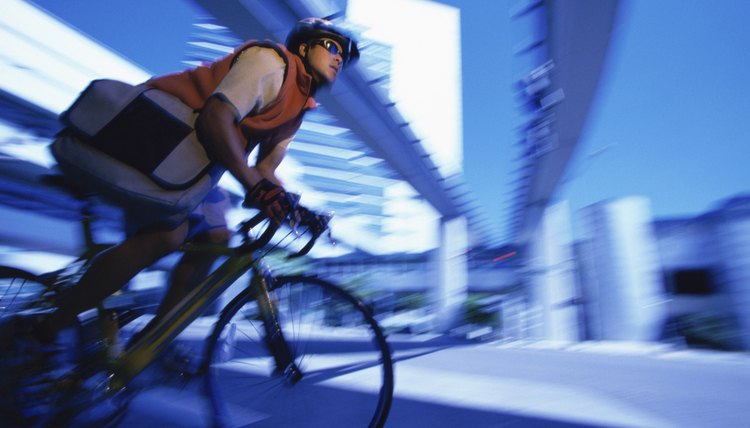Cycling With Runner's Knee

Runner's knee is a term used to describe a common syndrome that results from overuse of the knee. It affects people who flex their knees constantly such as runners and cyclists. Cycling with runner's knee requires rest, special exercises to strengthen your knee and possibly some changes to your bike fit.
Runner's Knee
Runner's knee is the nickname for a couple of conditions. Patellofemoral pain syndrome is when the patella, or knee cap, is misaligned on the groove in the femur, the bone in your thigh. Because the patella is no longer tracking properly, your femur is irritating the underside of the knee cap. The pain that results feels like it is coming from around or underneath your knee. It will start out as a gradual ache, eventually becoming so bad it will hurt all the time. Iliotibial Band Friction Syndrome manifests when the iliotibial band -- the tissue that connects the gluteal region to the outside of the tibia -- suffers from the friction of cycling with your knee bent at a 20 to 30 degree angle.
Treatment
Initially you’ll have to take a break from cycling. See your doctor as soon as you can for an exact diagnosis. In the meantime, follow the R.I.C.E. method of rest, ice, compression and elevation. Wrap an elastic bandage around your knee and elevate it on pillows to rest it. Apply ice packs for 20 minutes at a time. Your doctor may also suggest that you take anti-inflammatory medicine to help with pain and swelling.
Special Exercises
When your pain and swelling are reduced you can begin special exercises to rehabilitate your knee. This will require you to strengthen and stretch the muscles that support the knee. Most important are the quadriceps, hamstrings and iliotibial band. The quadriceps are in the front of your thigh and are responsible for stabilizing your knee cap and extending your leg. The hamstrings in the back of your thigh are responsible for bending your knee. When these muscles are strong they will absorb the pressure you place on your knee while cycling, which will reduce misalignment and also reduce pain.
Back in the Saddle
Once your knee is feeling better you can get back on your bike. However, you should consider making some changes when you cycle with runner's knee. First, look at your bike fit. A saddle that’s too low may be responsible for your condition. The saddle should be high enough so that your leg is still bent slightly at the bottom of a pedal stroke. When seated on your bike your toes should just touch the ground. The other change to make will be implementing a permanent routine of strengthening and stretching exercises three times a week to maintain your knee strength while cycling.
References
- American Family Physician; Patellofemoral Pain Syndrome: A Review and Guidelines for Treatment
- American Family Physician; Common Problems in Endurance Athletes
- Lespasio MJ, Piuzzi NS, Husni ME, Muschler GF, Guarino A, Mont MA. Knee Osteoarthritis: A Primer. Perm J. 2017;21:16-183. doi:10.7812/TPP/16-183
- Kiapour AM, Murray MM. Basic science of anterior cruciate ligament injury and repair. Bone Joint Res. 2014;3(2):20-31. doi:10.1302/2046-3758.32.2000241
- Doral MN, Bilge O, Huri G, Turhan E, Verdonk R. Modern treatment of meniscal tears. EFORT Open Rev. 2018;3(5):260-268. doi:10.1302/2058-5241.3.170067
- Reinking MF. CURRENT CONCEPTS IN THE TREATMENT OF PATELLAR TENDINOPATHY. Int J Sports Phys Ther. 2016;11(6):854-866.
- Petersen W, Rembitzki I, Liebau C. Patellofemoral pain in athletes. Open Access J Sports Med. 2017;8:143-154. doi:10.2147/OAJSM.S133406
- Frush TJ, Noyes FR. Baker's Cyst: Diagnostic and Surgical Considerations. Sports Health. 2015;7(4):359-65. doi:10.1177/1941738113520130
- Huang YC, Yeh WL. Endoscopic treatment of prepatellar bursitis. Int Orthop. 2011;35(3):355-8. doi:10.1007/s00264-010-1033-5
- Beals C, Flanigan D. A Review of Treatments for Iliotibial Band Syndrome in the Athletic Population. J Sports Med (Hindawi Publ Corp). 2013;2013:367169. doi:10.1155/2013/367169
- Tsai CH, Hsu CJ, Hung CH, Hsu HC. Primary traumatic patellar dislocation. J Orthop Surg Res. 2012;7:21. doi:10.1186/1749-799X-7-21
- Ragab G, Elshahaly M, Bardin T. Gout: An old disease in new perspective - A review. J Adv Res. 2017;8(5):495-511. doi:10.1016/j.jare.2017.04.008
- Lee PYF, Nixion A, Chandratreya A, Murray JM. Synovial Plica Syndrome of the Knee: A Commonly Overlooked Cause of Anterior Knee Pain. Surg J (N Y). 2017;3(1):e9-e16. doi:10.1055/s-0037-1598047
- Vaishya R, Azizi AT, Agarwal AK, Vijay V. Apophysitis of the Tibial Tuberosity (Osgood-Schlatter Disease): A Review. Cureus. 2016;8(9):e780. doi:10.7759/cureus.780
- Zanon G, Di vico G, Marullo M. Osteochondritis dissecans of the knee. Joints. 2014;2(1):29-36.
- Hindle P, Davidson E, Biant LC. Septic arthritis of the knee: the use and effect of antibiotics prior to diagnostic aspiration. Ann R Coll Surg Engl. 2012;94(5):351-5. doi:10.1308/003588412X13171221591015
- Gwinner C, Märdian S, Schwabe P, Schaser KD, Krapohl BD, Jung TM. Current concepts review: Fractures of the patella. GMS Interdiscip Plast Reconstr Surg DGPW. 2016;5:Doc01. doi:10.3205/iprs000080
- Voskuil R, Evenski AJ, Montgomery C, Emory CL. Malignant Bone Tumors of the Knee: How to Identify and Treat. J Knee Surg. 2019;32(4):305-314. doi:10.1055/s-0038-1675828
- Gupte C, St mart JP. The acute swollen knee: diagnosis and management. J R Soc Med. 2013;106(7):259-68. doi:10.1177/0141076813482831
- American Academy of Orthopedic Surgeons. Unstable Kneecap.
- Bhatia D, Bejarano T, Novo M. Current interventions in the management of knee osteoarthritis. Journal of Pharmacy & Bioallied Sciences 2013 Jan-Mar;5(1):30-38. doi:%2010.4103/0975-7406.106561
- Bronstein RD, Schaffer JC. Physical Examination of the Knee: Meniscus, Cartilage, and Patellofemoral Conditions. J Am Acad Orthop Surg. 2017 May;25(5):365-374.
- Browne K, Kurtz CA. How to perform a comprehensive examination of the knee. JAAPA. 2009 Jun;22(6):20-25.
- Hergenroeder AC, Harvey BS. (2017). Osteochondritis dissecans (OCD): Clinical manifestations and diagnosis. Bachur RG, ed. UpToDate. Waltham, MA: UpToDate Inc.
Writer Bio
James Roland started writing professionally in 1987. A former reporter and editor with the "Sarasota Herald-Tribune," he currently oversees such publications as the "Cleveland Clinic Heart Advisor" and UCLA's "Healthy Years." Roland earned his Bachelor of Science in journalism from the University of Oregon.
